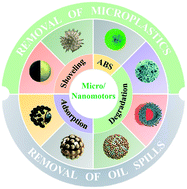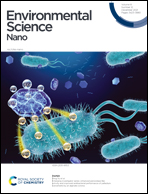Self-propelled micro/nanomotors for removal of insoluble water contaminants: microplastics and oil spills
Abstract
Micro/nanomotors (MNMs) provide a myriad of significant potential applications in the environmental field, due to their self-propulsion that enhances the mixing of liquid media at the micro/nanoscale. Currently, various soluble pollutants have been addressed using MNMs, including organic dyes, pharmaceutical drugs, and explosives. However the potential of MNMs to remove insoluble emerging pollutants, such as microplastics and oil spills, has been rarely explored. Bearing this in mind, herein, based on our experience in this field, as well as the potential problems, we take a different perspective by focusing exclusively on the core features of MNMs for removing insoluble pollutants. Such types of contaminants are more difficult to treat by the current wastewater treatments, entailing a huge risk to the environment. Following their developing tendency, we highlight the main types of MNMs, actuation modes, and removal mechanisms that have been developed so far in this research field. In this way, we provide guidance to fine tune the design of MNMs to become a key technology to address the uncontrollable contamination of insoluble pollutants in water, such as microplastics and oil spills.



 Please wait while we load your content...
Please wait while we load your content...